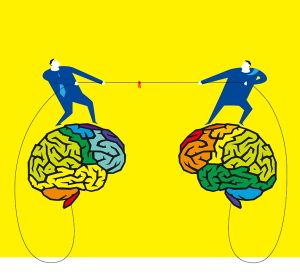If your leadership style leans to old school, take note: Neuroscience research shows that traditional management practices could actually be alienating employees and derailing company growth.
Our brains and bodies respond to social threats the same way they do with physical danger. The amygdala, the part of the limbic system that deals with emotions, goes into action. Stress chemicals such as adrenalin and cortisol, begin to flood your body. Your heart begins pumping more blood. Your breathing becomes more rapid. Your thyroid gland stimulates your metabolism.
This hyperalert state is just fine if you’re about to be attacked by a Bengal tiger and need to make a hasty exit. But it’s no state for making good decisions, thinking creatively or solving complex problems. Neuroscience informs us that when humans are responding to a threat, the prefrontal cortex of their brains suspends rational analysis and motivation in order to regulate the limbic system. So when the tiger jumps at you, you don’t stop to think — you run. This same response is evoked from employees on a daily basis by traditional command-and-control management practices.
In 2008 David Rock, author of “Quiet Leadership” and “Your Brain at Work,” introduced a framework to help leaders understand how employees respond to both threats and rewards in the workplace. His model comprises five different categories: status, certainty, autonomy, relatedness and fairness (SCARF).

Status. Humans are hardwired to consider the relative significance of others they encounter and subconsciously compare such things as personal appearance and symbols of wealth and power. In the business arena there are a number of things can affect status. For starters, there’s the physical environment: Someone else’s office may be bigger, have a better view or be in a more prominent location.
Status can also be negatively affected when you give someone advice or tell them what to do. Advice-giving is perceived as negative because you’re essentially putting the other person down by inferring they are less intelligent than you.
In contrast to “telling,” I recommend that leaders take an approach of inquiry (see “Don’t Fall Down As You Staff Up”). By asking employees questions, you change the “status see-saw” because you’re temporarily lowering your status and making yourself vulnerable. You’re showing them that your opinion isn’t the only one that counts.
Status can also be used as a reward. One simple way is to recognize your people and their efforts — both casually and publicly. Two quick caveats: 1) You need to be genuine about it, and 2) make sure you aren’t pitting employees again each other, which can happen in such initiatives as employee-of-the-month awards. When you raise the status of one individual, be sure to consider how it may affect others in the company.
Certainty. Humans like to know what’s going to happen next. And some people need to know more than others.
Uncertainty can generate stress in a variety of scenarios. If you’re a leader who constantly changes directions — a common characteristic of hard-charging entrepreneurs who love to chase after new opportunities — then you’re probably triggering the threat response in employees. Once again, they can’t make great decisions because they can’t predict what you’ll do next.
External sources can also spark uncertainty, such as industry turbulence or economic downturns. Granted, you don’t have control over these outside forces, but you do have control over your reactions. To reduce uncertainty, tell employees as much as you can about what you think is happening or what could happen. Especially during times of change, it’s important for a leader to overcommunicate.
Case in point, I once worked for a company that went through a merger, and for several months, everyone was on edge. To help reduce anxiety, our CEO sent out a group voicemail every morning (this was before email). He let us know about new developments and addressed questions people were having, such as what would happen with staffing and finances. He didn’t have every single answer, but at least he talked about it, which reduced my stress.
Autonomy. This is about having a sense of control over your environment, the ability to have choices. Autonomy doesn’t mean anarchy or letting everyone do whatever they want. Yet if people don’t have a certain amount of flexibility with work responsibilities, such as when, where or how they do their jobs, they’re certain to become disengaged.
Autonomy is especially critical for anyone who is part of what Richard Florida calls “the Creative Class” — knowledge-based workers tasked with problem-solving and innovation. It’s important to understand that the muse doesn’t necessarily whisper in the ears of these folks between the hours of 9 and 5. Obviously, there are some positions where people have to show up at a certain time, but you can still be creative about giving these individuals flexibility in other areas, such as what projects they work on, who they work with, or setting their own goals.
Autonomy is a tough concept for many CEOs because they think employees will underperform. I like to remind them how much they like autonomy — for many, it was one of the reasons they launched their company. At the end of the day, what’s important is results.
Still skeptical? Then try autonomy in small doses and expand from there. Autonomy is a driving force of motivation. Use it to your advantage.
Relatedness. This is about inclusion and exclusion — being allowed in a group of our preference versus being blocked from joining. Exclusion can cause us to experience the threat response.
Additionally, if we’re with people we don’t like, our threat response gets triggered. And conversely, if we’re with people we do like, the reward response kicks in. In fact, when people make a positive social connection with each other, their brains release oxytocin, a feel-good hormone.
There’s an interesting phenomenon about social and psychological barriers to mention. If employees not only like who they work with, but also believe they’re working with elite people, then they will relate to the team and work hard. On the other hand, if your company is losing talent and you start bringing in yo-yos, employee engagement could drop dramatically because the group loses its identity.
The key takeaway here: As a CEO, you want to create a strong brand for your company, the feeling that “this is our tribe.” You want to make the company seem special to join. If anyone can belong, there’s no sense of identity.
Fairness. Equity is a huge thing for employees, and they tend to be hypersensitive about equity and justice. The decisions you make as a leader need to be perceived as fair and what’s best for the organization. Otherwise, you’re triggering the threat response.
Some quick examples of actions that will be viewed as unfair:
- Giving preferential treatment to an employee because he is a friend or relative.
- Promoting people based on tenure versus expertise.
- A salary cutback that isn’t universal.
If employees think their CEO is even contemplating something unfair, they may react negatively.
Some final words
The human brain is motivated primarily by two questions: Does this situation pose a threat or a reward?
Over the centuries, our species has learned to pay particular attention to physical threats because they usually result in pain and possible death. In recent years, research has shown that our brains react in the same manner to social threats and rewards. One nuance: when it comes to social pain, the brain reacts for a longer timeframe and more intensely than it does to physical pain.
The SCARF model is intriguing in that it addresses engagement from a neurological perspective. It’s important to remember that leadership is an act of influence. Leaders of the future must be keenly aware to influence people’s minds, not their muscles.
(Published July 6, 2016)
